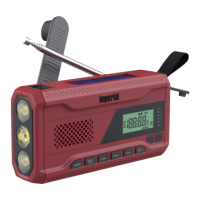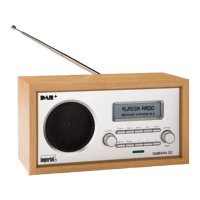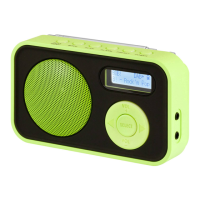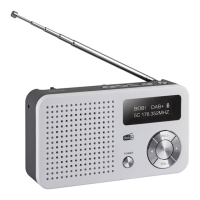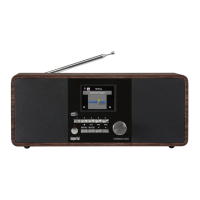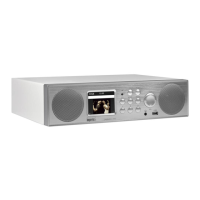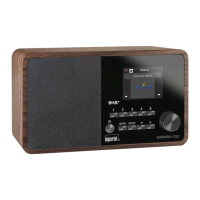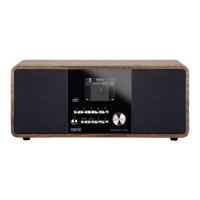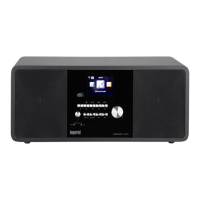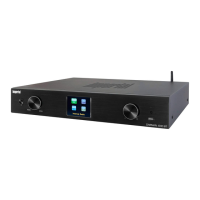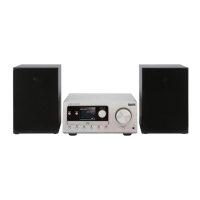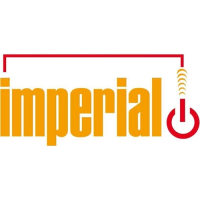Do you have a question about the Imperial DABMAN PBB 2 and is the answer not in the manual?
Defines the product's purpose as a consumer electronics device for radio reception and audio playback.
Explains various warning symbols used in the manual, including danger, warning, caution, and specific device symbols.
Provides general safety advice for device usage, including warnings for children and suffocation risks from packaging.
Details safety precautions during operation, such as electric shock risks, using the correct adapter, and avoiding hazardous areas.
Explains how to safely connect the device to a power source, emphasizing proper installation and socket accessibility.
Advises on environmental conditions to avoid, such as moisture, heat, dust, and direct sunlight, to prevent damage.
Warns about potential hearing damage from excessive sound pressure when using earphones or headphones.
Discusses the device's electromagnetic field generation and its potential effects on medical devices.
Provides critical safety instructions for battery handling, including polarity, charging, and disposal to prevent injury or explosion.
Gives instructions on how to clean the device safely using a soft, dry cloth and avoiding solvents or liquids.
Details the functions of the buttons and the CD drive located on the front panel of the device.
Describes the controls and connections found on the back of the device, including the antenna and power input.
Instructions for connecting the device to mains power, including socket specifications and cable usage.
Guidance on inserting and using batteries for portable operation, emphasizing correct polarity and battery type.
Instructions to remove protective packaging from the CD player's laser unit before the first use.
Steps to power the device on from standby mode and how to switch it off completely.
Explains how to adjust the audio volume using the dedicated volume knob on the device.
Details how to switch between different operating modes such as DAB, FM, CD, USB, and AUX.
Procedure for manually setting the current date and time on the device display.
Provides a definition and benefits of DAB+ digital radio, explaining ensembles and multiplex broadcasting.
Instructions on how to enter DAB mode and the automatic station search process upon first use or empty station list.
Steps to manually tune and select available DAB+ radio stations using the control knobs.
Guide to performing an automatic scan for DAB/DAB+ stations and how to initiate a broader national/local search.
Details how to perform a manual search for specific DAB stations by frequency to find the strongest signal.
Instructions on how to store up to 30 favourite DAB/DAB+ stations into memory slots for quick access.
How to recall and play previously saved DAB/DAB+ stations from the memory slots.
Explains the various types of information displayed for DAB stations, such as DLS, PTY, signal strength, and time.
Guide to performing an automatic scan for FM stations and how found stations are automatically saved.
Instructions for manually tuning into FM stations by frequency to find the best signal.
Steps to store up to 30 favourite FM stations into memory slots for easy retrieval.
How to recall and play previously saved FM stations from the memory slots.
Explains the information displayable for FM stations, including RDS, Programme Type, and Programme Name.
Instructions on selecting CD mode and inserting a CD into the player for reading.
Details on how to play, pause, skip tracks, and stop playback of a CD.
Explains available playback modes like repeat track, repeat all, and intro scan for CD playback.
Instructions for USB mode setup, inserting devices, and playing MP3 files, including pause, skip, and stop functions.
Steps to connect external sources via 3.5mm cable and operate in AUX mode, controlling volume via the device.
How to set a sleep timer to automatically switch the radio to standby mode after a specified duration.
Instructions for manually setting the date and time, including automatic updates and time format.
How to adjust the brightness of the device display for both operation and standby modes.
Procedure to select the preferred language for the device interface from the available options.
How to adjust the sound settings using preset equalizer options or custom bass and treble controls.
Guide to restoring the device to its original factory settings, including deleting stored stations and reconfiguring language.
How to query and view the currently installed software (SW) version of the device.
Instructions on how to properly dispose of the product's packaging materials, which are recyclable.
Information on the proper disposal of the device according to EU directive, emphasizing collection centres and recycling.
Guidance on the separate disposal of batteries and battery packs, highlighting environmental protection and chemical content.
| Radio type | Portable |
|---|---|
| Tuner type | Analog & digital |
| FM band range | 87.5 - 108 MHz |
| DAB band range | 174.5 - 240 MHz |
| Supported radio bands | DAB, DAB+, FM |
| RMS rated power | 2 W |
| Number of built-in speakers | 2 |
| Display type | LCD |
| Headphone outputs | 1 |
| Headphone connectivity | 3.5 mm |
| USB 2.0 ports quantity | USB 2.0 ports have a data transmission speed of 480 Mbps, and are backwards compatible with USB 1.1 ports. You can connect all kinds of peripheral devices to them. |
| Projection | No |
| Antenna type | External |
| Product color | Black, Stainless steel |
| Compatible battery sizes | C |
| Number of batteries supported | 6 |
| Power source | AC/Battery |
| AC input voltage | 230 V |
| AC input frequency | 50 Hz |
| Power consumption (typical) | 8 W |
| Operating temperature (T-T) | 5 - 40 °C |
| Operating relative humidity (H-H) | 5 - 90 % |
| Cables included | AC |
| Width | 240 mm |
|---|---|
| Height | 117 mm |
| Weight | 1000 g |
